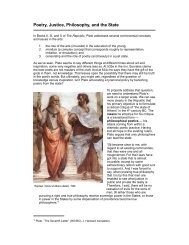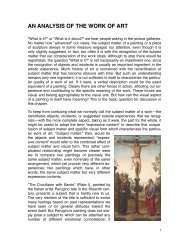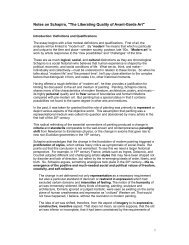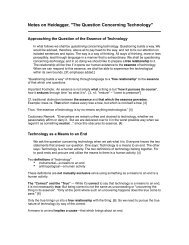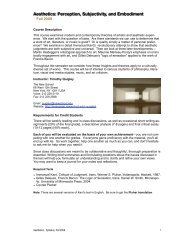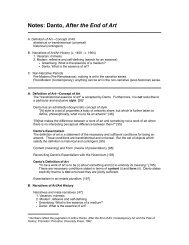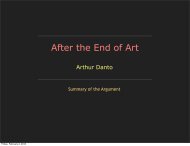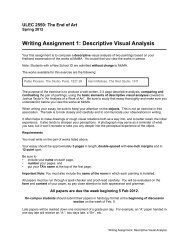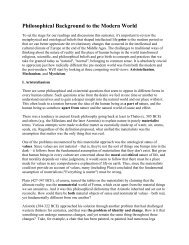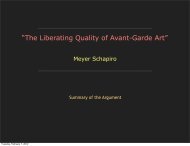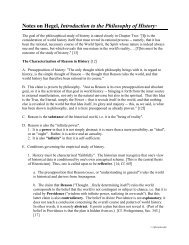Create successful ePaper yourself
Turn your PDF publications into a flip-book with our unique Google optimized e-Paper software.
This strikes me as comparable toNietzsche's notion of the artist in hisDionysian mode as vehicle for thatwhich is expressed through him in awilling self-abnegation. [??]The actions most proper to him—those gestures, those tracings of which he alone iscapable <strong>and</strong> which will be revelations to others because they do not lack what he lacks—to him they seem to emanate from the things themselves, like figures emanating from theconstellations.Inevitably the roles between the painter <strong>and</strong> the visible switch. That is why so manypainters have said that things look at them. As Andre March<strong>and</strong> says, after Klee: "In aforest, I have felt many times over that it was not I who looked at the forest. Some days Ifelt that the trees were looking at me, were speaking to me…. I was there, listening…. Ithink that the painter must be penetrated by the universe <strong>and</strong> not want to penetrate it…. Iexpect to be inwardly submerged, buried. Perhaps I paint to break out."[9]We speak of "inspiration," <strong>and</strong> the word should be taken literally. There really isinspiration <strong>and</strong> expiration of Being, respiration in Being, action <strong>and</strong> passion so slightlydiscernible that it becomes impossible to distinguish between who sees <strong>and</strong> who is seen,who paints <strong>and</strong> what is painted. We say that a human being is born the moment whensomething that was only virtually visible within the mother's body becomes at once visiblefor us <strong>and</strong> for itself. The painter's vision is an ongoing birth.In paintings themselves we could seek a figured philosophy[10] of vision—itsiconography, perhaps. It is no accident, for example, that frequently in Dutch paintings(as in many others) an interior in which no one is present is "digested" by the "round eyeof the mirror".[11] This prehuman way of seeing things is emblematic of the painter's way.More completely than lights, shadows, <strong>and</strong> reflections, the mirror image anticipates,within things, the labor of vision. Like all other technical objects, such as tools <strong>and</strong> signs,the mirror has sprung up along the open circuit between the seeing <strong>and</strong> the visible body.Every technique is a "technique of the body," illustrating <strong>and</strong> amplifying the metaphysicalstructure of our flesh. The mirror emerges because I am a visible see-er, because there isa reflexivity of the sensible; the mirror translates <strong>and</strong> reproduces that reflexivity. In it, myexternality becomes complete. Everything that is most secret about me passes into thatface, that flat, closed being of which I was already dimly aware, from having seen myreflection mirrored in water. Schilder observes that, smoking a pipe before a mirror, I feelthe sleek, burning surface of the wood not only where my fingers are but also in thoseotherworldly fingers, those merely visible ones inside the mirror.[12] The mirror's phantomdraws my flesh into the outer world, <strong>and</strong> at the same time the invisible of my body caninvest its psychic energy in the other bodies I see.[13] Hence my body can includeelements drawn from the body of another, just as my substance passes into them; man isa mirror for man. Mirrors are instruments of a universal magic that converts things intospectacle, spectacle into things, myself into another, <strong>and</strong> another into myself. Artists haveoften mused upon mirrors because beneath this "mechanical trick," they recognized, asthey did in the case of the "trick" of perspective,[14] the metamorphosis of seeing <strong>and</strong>seen that defines both our flesh <strong>and</strong> the painter's vocation. This explains why they haveso often chosen to draw themselves in the act of painting (they still do—witness Matisse'sdrawings), adding to what they could see of things at that moment, what things could seeof them—as if to attest to there being a total or absolute vision, leaving nothing outside,including themselves. Where in the realm of the underst<strong>and</strong>ing can we place these occultoperations, together with the potions <strong>and</strong> idols they concoct? What can we call them?Consider, as Sartre did in Nausea, the smile of a long-dead monarch which keepsproducing <strong>and</strong> reproducing itself on the surface of a canvas. It is too little to say that it isthere as an image or essence; it is there as itself, as that which was always most aliveabout it, the moment I look at the painting. The "world's instant" that Cézanne wanted topaint, an instant long since passed away, is still hurled toward us by his paintings.[15] HisMont. Sainte-Victoire is made <strong>and</strong> remade from one end of the world to the other in a waydifferent from but no less energetic than in the hard rock above Aix. Essence <strong>and</strong>existence, imaginary <strong>and</strong> real, visible <strong>and</strong> invisible—painting scrambles all ourcategories, spreading out before us its oneiric universe of carnal essences, actualizedresemblances, mute meanings.6



